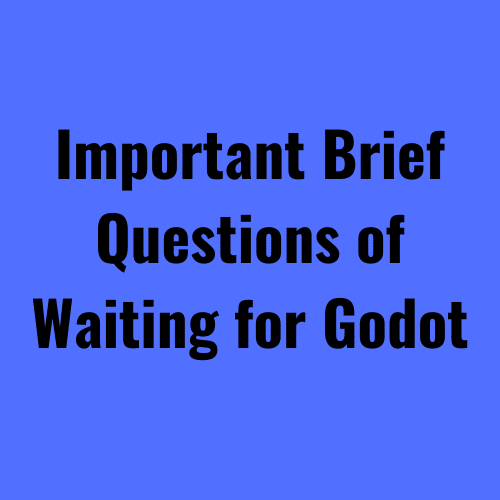38 Important Brief Questions of Waiting for Godot
Q.1. Who is Samuel Beckett? 1986
Ans. An Irish dramatist and novelist belonging to the Theatre of the Absurd
Q.2. When was Beckett awarded the Nobel Prize?
Ans. In 1969, for Literature.
0.3 What is Theatre of the Absurd?
Ans. A kind of drama growing out of the philosophy of existentialism and flourishing in Europe and America in the 1950s and 1960s.
Q. 4. How is the title, Waiting for Godot justified?
Ans. Since the main theme of the play is ‘waiting for some ‘Godot‘, or for something or the other, it is entitled so.
Q.5. Who are the major characters in Waiting for Godot and what nationalities do they represent and why?
Ans. Estragon, a Frenchman; Vladimir, a Russian; Pozzo, an Italian; and Lucky, an Englishman.
Q.6. What is the subject of the song sung by Vladimir?
Ans. the story of a dog that had stolen a piece of bread from a kitchen and which had been beaten to death by the cook.
7. What is the symbolic meaning of the name of Vladimir?
Ans. Vladimir or Didi symbolizes rationality in man’s nature.
Q.8. How are Gogo and Didi represented as parts of a divided self?
Ans. Gogo is the Unconscious Mind, the ID, that part of the To human personality. Didi expresses the Conscious Mind, the EGO.
Q.9. Why Gogo and Didi cannot separate themselves once and for all?
Ans. Gogo and Didi are the two aspects of the human psyche, the ID and EGO respectively.
Q.10. Who is Pozzo in Waiting for Godot?
Ans. A traveling rich man dressed elaborately.
Q. 11. What does Pozzo represent?
Ans. The personification of Row Power.
Q.12. Who is Lucky in Waiting for Godot?
Ans. The slave or servent of the Pozzzo.
Q.13. What does Estragon try to do sitting on the mound?
Ans. Estragon, sitting on the mound, is trying to take off his boot.
Q.14. What does Estragon’s lying in a ditch at night signify?
Ans. The impoverished and miserable conditions of the two tramps.
Q.15. What did Estragon see in the Holy Bible?
Ans. In the Holy Bible, he saw the maps of the Holy Land including the Dead Sea, the water of which was pale blue.
16. What is existentialism?
Ans. It is a form of philosophical inquiry that expresses the problems of human existence and emphasizes thoughts, feelings and experiences of acting.
Q.17. What do Gogo’s nightmares symbolize?
Ans. The discomfort and disquiet in their situation.
Q.18. What is “mandrakes”?
Ans. An ancient symbol of fertility.
Q.19. Why does Estragon give his name as ‘Adam’ to Pozzo?
Ans. Because he readily plays the role of the latter’s interlocutor.
Q.20. Can you guess any meaning/significance of Lucky’s speech?
Ans. Lucky’s speech is a scholarly, theological address, but it is actually a parody of this kind of address full of nonsensical and absurd elements.
Q.21. What does the tree with four or five leaves in the setting of Act II signify?
Ans. Traditionally, a tree sprouting leaves would denote renewal of life or hope, but here it does not signify hope; it only records the passage of time.
Q.22. What does the “Macon Country” refer to?
Ans. The Garden of Eden.
Q.23. What does Estragon mean by “Cackon Country”?
Ans. It means the present world.
Q.24. What insight does Pozzo acquire in his blindness?
Ans. In his blindness, Pozzo acquires a new more meaningful insight into the nature of time and human existence.
Q.25. How does Pozzo philosophize human life?
Ans. To blind Pozzo, the moment of death is the same as the moment of birth.
Q.27. What does the word “Godot” refer to?
Ans. Godot refers to the Biblical image of God.
Q.28. What does Pozzo’s blindness signify?
Ans. Pozzo’s blindness expresses his confusion over time.
Q.29. What does Vladimir give Estragon to eat when he feels hungry?
Ans. When Estragon feels hungry Vladimir takes out a carrot from his pocket and gives it to Estragon to eat.
Q.30. What does Lucky symbolize?
Ans. The submissive slave such as the Biblical ass.
Q.31. Who utters the words “nothing to be done” at the opening of Waiting for Godot?
Ans. Estragon.
Q.32. Who are the tramps in Waiting for Godot?
Ans. Estragon (Gogo) and Vladimir (Didi).
33. What does the tree represent in the play ‘Waiting for Godot’?
Ans. The Tree represents hope.
Q.34. Name the main characters of the play ‘Waiting for Godot’?
Ans. Estragon, Vladimir, Pozzo, Lucky, Boy
Q.35. How is the hope of the tramps deferred?
Ans. The tramps’ hope is deferred because of their sickness of heart.
Q.36. What is the significance of the Pozzo-Lucky relationship?
Ans. Master and slave, or capital and labor, or wealth and artist, or body and intellect, or mankind and Christ.
Q37. What do the two tramps symbolize?
Ans. The ordeal of waiting by human beings for a golden future, a better society, for şalvation, or for a savior or for death.
Q.38. How does Pozzo address Lucky?
Ans. Pozzo addresses Lucky as “pig” and “hog”.
